Australia So Much to See


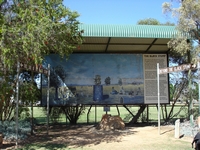
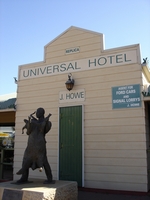
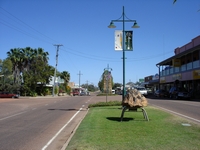
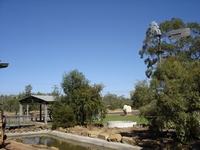
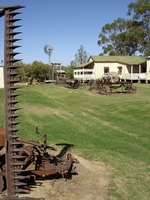
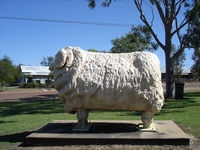
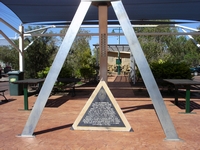
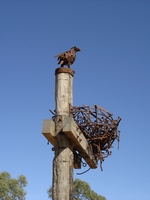
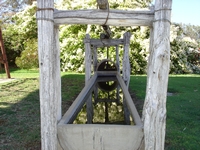
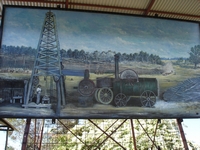
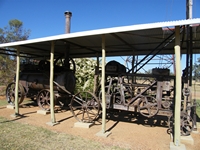
Blackall: A town on the banks of the Barcoo River with so much history
Blackall Shire Council
Blackall Bore No. 1
(Dicksons)
Date commenced December 1885
Date completed 26th April 1888
Flow registered 210,000 gallons per day
Present day flow 38,500 gallons per day
Source Artesian
Depth 1,663 feet
Temperature 119º F
Blackall was selected as the first place in
A detailed mural by local artist Bob Wilson depicts drilling operations in the early 1900s and sets the scene for the now capped borehead
and information plaque and f or two pieces of restored machinery.
This shop is a replica of the facade of the Universal Hotel, most famous for being owned by world champion blade shearer Jack Howe. In 1892 Jack shore 321 sheep with blades in one working day at Alice Downs, north of Blackall.
He retired from shearing when
he was 39 to become a publican, owning the Universal Hotel on two separate occasions; from 1900 to 1902 and again from 1907 to 1919. He was said to have a fine signing voice and often entertained Hotel patrons with popular songs of the day.
While he was at the
From signage at the site
Upon invitation by Blackall residents Jack Howe and Paddy Sheehan to run for the seat of Barcoo, Thomas Joseph (T.J.) Ryan (1876-1921)
was elected at the state member for that seat in 1909. He and his Government were both innovative and effective, especially
in the area of industrial reform. In 1919 he resigned as Premier of Queensland to enter Federal Parliament. He gained
popularity because of his concern for the rights of the worker, small business operators and landholders of the time.
It was the lowering of the shearing rate in 1886 that led shearers from Isis Downs to meet in Blackall to fight the directives of
the pastoralists. This resulted in the formation of the Queensland Shearers Union and in December 1887, Bill Kewley, a Blackall
resident, was appointed its secretary. He was an efficient, hard working and well respected man and also became involved in
the largest and most successful workers’ political organisation in
At its first General Council meeting in
During the 2007 Heartland Festival, Blackall housed metal sculptor Richard Moffat as an in-resident artist. Richard created three
unique pieces of art for Blackall. The first of is the Eagles Nest which is located down at the
The first shearer’s union meeting was held in Blackall in December 1886 and formed the foundations of the Australian Labor Party.
This Labor Federation Memorial commemorates that historic event with three stories.
This fossilised tree stump is on display in the main street of Blackall and is a conifer related to the hoop pines. The stump
was preserved by opalisation and silification
This eagle is my favourite of the three sculptures. Cleverly created with a nest of scrap metal, the eagle is on a high pole
near the bridge across the
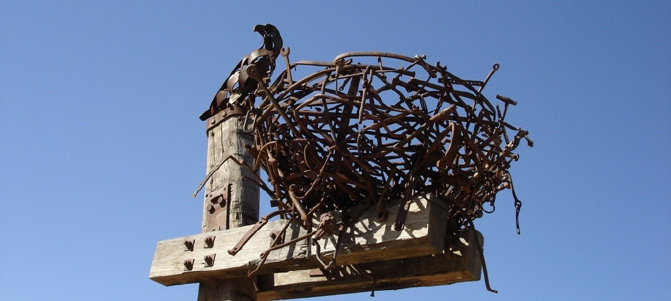
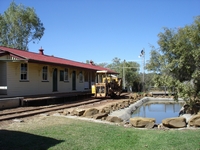
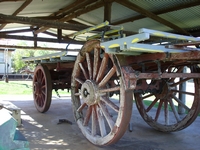
From the campground it is a short walk to the town centre and most other sites are within easy walking distance. We found this brochure with map ideal for our walk around the town.
Blackall was one of the first towns to drill for artesian water with the first bore, known as the Pioneer Bore being sunk in 1885.
Replica of the steam-operated percussion drilling rig is on display at the site.
In 1901 the number 2 bored was drilled
to 900 metres and delivered 6,800 litres per day, coming out of the ground at 58º C. It was the first bore in
Blackall’s water is now supplied from
town bore number 4 in
In 1913 the deepest
artesian water bore in Southern Hemisphere was sunk to a depth of 2,100 metres at Springleigh Station, eighty kilometres south west
of Blackall.
A rural theme museum is known as
Blade shearer Jackie Howe put Blackall on the map when at local station Alice Downs when he set a world record in 1892 by shearing
321 sheep in seven hours and forty minutes with blade shears. It took another 58 years before anyone could match this feat,
and that was by machine shears.
Wearing a flannel shirt when shearing to keep his back warm, Jack found the sleeves hot
and restrictive so tore them out. The blue flannel singlet known as a Jackie Howe became the standard shearing shirt across
the country.
Jack Howe’s grave can been seen at the
This park has several historic buildings including Navena Homestead and the old railway station. Work was being undertaken on
the relocated and reconstructed railway station which was not open to the public at that stage. The large bullock dray came
from the Bollon area. The big ram signifies the importance the wool industry held in the Blackall region. Cropping machinery
including a combine and a hay making equipment are in the outdoor display.
This historic site marks the original Astro Station established in 1887 by the Surveyor General for the purpose of the survey based
on the principal meridional circuit traverse around the town of
This Astro Station was used as part of the survey to fix the position of principal towns extending from Brisbane to Boulia via Roma, Charleville and Blackall. This was designed to establish the points of important centres with which the survey work of the whole colony could be connected, and enable the mapping of Queensland on a more accurate basis. It was considered at the time that country to the west of Blackall was “beyond the Black Stump”.
This piece of petrified wood replaces the original stump which was burnt out.